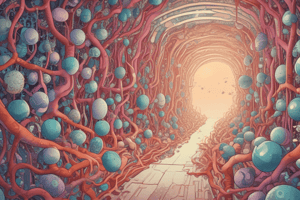Podcast
Questions and Answers
What is the main difference between sterile and antiseptic techniques?
What is the main difference between sterile and antiseptic techniques?
- Antiseptic technique uses heat to kill microorganisms.
- Sterile technique involves the use of antiseptic solutions.
- Sterile technique involves the elimination of all microorganisms, whereas antiseptic technique reduces the number of microorganisms. (correct)
- Antiseptic technique is used for internal organs, whereas sterile technique is used for external surfaces.
What is the primary requirement for microbial growth?
What is the primary requirement for microbial growth?
- Presence of water
- Presence of light
- Presence of oxygen
- Presence of nutrients (correct)
What percentage of water do cells typically consist of?
What percentage of water do cells typically consist of?
- 70% - 80%
- 90% - 95%
- 95% - 100%
- 80% - 90% (correct)
What is the term for the process of inhibiting microbial growth using physical methods?
What is the term for the process of inhibiting microbial growth using physical methods?
What is the term for the growth of microorganisms at moderate temperatures?
What is the term for the growth of microorganisms at moderate temperatures?
What is the suffix that means 'kill organisms'?
What is the suffix that means 'kill organisms'?
What is the term for the presence of pathogens in blood or tissues?
What is the term for the presence of pathogens in blood or tissues?
What is the term for the elimination of all microorganisms?
What is the term for the elimination of all microorganisms?
What is the term for the growth of microorganisms in a controlled environment?
What is the term for the growth of microorganisms in a controlled environment?
What is the term for the four stages of microbial growth?
What is the term for the four stages of microbial growth?
Flashcards are hidden until you start studying
Study Notes
Types of Culture Media
- Enriched medium: a broth or solid medium containing a rich supply of special nutrients that promotes the growth of fastidious organisms (e.g., blood and chocolate agar)
- Selective medium: used to discourage the growth of certain organisms without inhibiting the growth of the organism being sought
- Differential medium: permits the differentiation of organisms that grow on the medium
Inoculation of Culture Media
- Culture media are routinely inoculated with clinical specimens
Importance of Aseptic Technique
- Aseptic technique is practiced to prevent:
- Microbiology professionals from becoming infected
- Contamination of their work environment
- Contamination of clinical specimens, cultures, and subcultures
- Contaminants: unwanted organisms
Incubation
- Incubation: placing inoculated media into a chamber (incubator) with the appropriate atmosphere, moisture level, and temperature
- Types of incubators:
- CO2 incubators
- Non-CO2 incubators
- Anaerobic incubators
- A pure culture: a culture that contains only one species of organism
Bacterial Population Counts
- Determining:
- Total number of bacterial cells in the liquid (includes both viable and dead cells)
- Number of viable (living) cells
Physical Factors Affecting Microbial Growth
- pH: hydrogen ion concentration of a solution, affecting acidity or alkalinity of the solution
- Most microorganisms prefer a neutral or slightly alkaline growth medium (pH 7.0–7.4)
- Osmotic pressure: pressure exerted on a cell membrane by solutions inside and outside the cell
- Barometric pressure: most bacteria are not affected by minor changes in barometric pressure
- Gaseous atmosphere: microorganisms vary in their requirements for gaseous atmosphere
Culturing Bacteria in the Laboratory
- Bacterial growth: an increase in the number of organisms, not their size
- Bacteria multiply by binary fission
- Generation time: the time taken by a particular bacterial species to undergo binary fission
- Microorganisms that are difficult to grow in the laboratory are said to be fastidious
Culture Media
- Artificial media or synthetic media: prepared in the laboratory
- Types of culture media:
- Chemically defined medium: all ingredients are known
- Complex medium: contents are not known
Studying That Suits You
Use AI to generate personalized quizzes and flashcards to suit your learning preferences.



